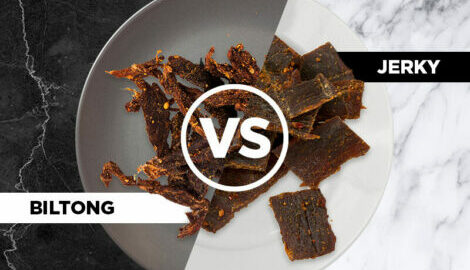
Beef Jerky vs Biltong vs Steak Strips: What Are They?
We’re sure you’re familiar with savory, rip and tear jerky. But have you heard of biltong or steak strips? You may have seen these snacks while perusing the grocery aisle which may have left you wondering—what’s the difference? After all, it’s all dried meat, right?
While this is true, there are some key differences between these protein-packed snacks. Here, we’ll dive into those differences, so you can choose a snack you’ll feel good about.
What Is Biltong?
Biltong is a dried meat snack similar to beef jerky or steak strips. However, biltong is a bit different when it comes to ingredients typically used and the drying process.
The Ingredients
Biltong can be made out of any meat, including beef, poultry, fish, or game meats like venison (deer). Most biltong is made using traditional ingredients, including rock salt, coriander seeds, and vinegar. Vinegar is a key ingredient as it gives biltong its unique flavor. It also softens the dried meat and works to cure it as it dries.
The Texture
Some say biltong has a more steak-like texture than beef jerky or meat strips. It also tends to be somewhat softer when compared to other snacks. Biltong is thicker than other meat snacks too and can be a bit chewy, depending on how it’s cut.
How It’s Made
The key difference between biltong and other meat snacks is how it’s made. Biltong is made without heat. That’s right—biltong is air-dried instead of slow-cooked in a dehydrator like beef jerky or meat strips. Drying time can take a week or longer, depending on things like the weather and how you want it to taste.
How does the biltong not go bad while it’s drying? We had the same question too. Biltong is cured with vinegar which keeps it from spoiling as it dries. Plus, this curing process keeps biltong tasty after drying. It can last 4-6 hours after drying but longer if kept vacuum-sealed and in the fridge.
The History of Biltong
Biltong has been loved for centuries throughout sub-Saharan Africa, including Zimbabwe, Zambia, and Botswana. Back before we had fridges, indigenous people had to be creative in storing the meat needed to feed their families. So, they used natural ingredients like salt and air to dry meat to enjoy later.
Over the years, other groups adopted the method of air-drying meat. European settlers arriving in South Africa added the vinegar that’s common today while Dutch farmers gave biltong its name using Dutch words “bille” for buttock and “tonghe” for strip or tongue.
Now, biltong is eaten by all in South Africa and is typically enjoyed with friends and family. It’s a snack food that’s simple and loved by all.
How Is Biltong Different From Jerky?
Let’s take a quick second to recap beef jerky vs biltong. While jerky is dehydrated using heat, biltong is air-dried. Biltong is often thicker than jerky, has a softer, chewy texture, and a unique flavor due to the vinegar used to cure it.
What Are Dried Steak Strips?
Dried beef strips (or steak strips) are also different from biltong and jerky. While they are more similar to jerky, there are key differences in the make-up of meat strips and their drying process. Let’s dive in!
The Ingredients
Meat strips are typically made using ingredients similar to those found in jerky. The flavor of the strip dictates which ingredients are used. For example, you may find ingredients such as salt, soy sauce, Worcestershire sauce, or even molasses in your meat strips.
Meat strips can be made from a variety of meats, including beef and chicken, so long as it is properly dried.
The Texture
For beef jerky to be considered jerky, it must meet a certain moisture-to-protein ratio (MPR) according to the USDA. Meat strips typically have more water content, so they’re unable to be called beef jerky.
This is good news, as more water equals a softer bite. You won’t find the traditional rip and pull found in jerky inside a meat strip. Instead, strips are tender and delicious.
How It’s Made
Meat strips are made using the same process as beef jerky. Meat is marinated in salt and other good stuff for curing and then it’s dried. However, meat strips aren’t dried for as long as traditional jerky, which also results in a softer bite.
How Are Meat Strips Different Than Jerky?
As a recap, tender dried meat strips are softer and easier to bite than traditional beef jerky. This is due to a shorter drying process and the increased water content inside the strip.
Meat strips are also often lower in sodium than jerky. For example, traditional beef jerky contains around 505mg of sodium per ounce. And Lorissa’s Kitchen meat strips contain only 270mg of sodium per ounce.
|
Beef Jerky |
Meat Strips |
|
|
|
|
|
|
The History of Meat Strips at Lorissa’s Kitchen
Lorissa’s first job was on a farm near her home where she grew to appreciate real ingredients. And when she became a mom, she wanted convenient yet yummy snacks to fuel herself and her busy family. Lorissa’s Kitchen was created and the rest is history.
Here at Lorissa’s Kitchen, we believe you deserve fuel-good snacks that keep you going. What you grab between meetings and soccer games should be packed full of protein without all the yucky additives such as preservatives, nitrites, or nitrates.
That’s why our meat strips are made using simple ingredients and 100% grass-fed beef. They’re gluten-free, keto-friendly, and completely delicious.
Fuel Up & Go With Lorissa’s Kitchen Meat Strips
Fuel yourself and your family with Lorissa’s Kitchen meat strips. From traditional flavors to sweet teriyaki, we have a gluten-free, protein-packed meat strip for everyone in your family. To learn more or to try Lorissa’s Kitchen today, shop our products.
Lorissa’s Kitchen does not provide medical advice, diagnosis, or treatment. Any information published on this website or by this brand is not intended as a substitute for medical advice, and you should not take any action before consulting with a healthcare professional.
